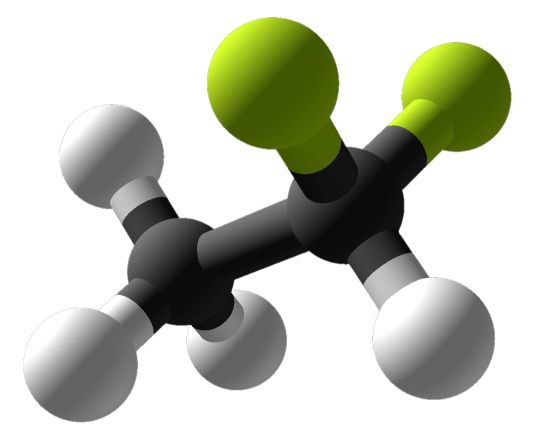Difference Between HCFC and HFC
The key difference between HCFC and HFC is that HCFC contains chlorine and can cause harm to the ozone layer, whereas HFC is free of chlorine and does not harm the ozone layer.
HCFCs and CFCs are gases that are phased out currently from their use due to considerations regarding the harm they can cause to the ozone layer of the stratosphere. HFC is a good replacement for these gases, mainly in refrigerators.
CONTENTS
1. Overview and Key Difference
2. What is HCFC
3. What is HFC
4. Side by Side Comparison – HCFC vs HFC in Tabular Form
5. Summary
What is HCFC?
HCFC refers to hydrochlorofluorocarbon. It is a class of compounds having a chemical structure very similar to CFC. However, unlike CFC, these compounds contain hydrogen atoms, in addition to the carbon, fluorine and chlorine atoms. Under normal conditions, these are either gases or highly evaporative liquids. Generally, they are stable and unreactive.
These compounds are very useful substituents for CFCs. They are useful as refrigerants and in insulative foams. However, people do not use them as solvents, and many developed countries have banned them from use as solvents. More importantly, these compounds do not have any immediate impacts on the environment after release to the environment. Due to their volatile nature, they can involve in reactions that produce ozone at the lower atmosphere level, which can damage plants. Since they are not as stable as CFC and are not so persistent in the atmosphere, the effects on the atmosphere are very less. However, these compounds can still end up in the upper atmosphere, causing a very slow depletion of ozone.
What is HFC?
HFC is hydrofluorocarbon. These are manmade organic compounds having fluorine and hydrogen atoms. It is the most common type of organofluorine compound that occurs mostly in the gas phase at room temperature. These gases usually are useful in air conditioning and as refrigerants. E.g. R-134a is a common HCF refrigerant. These compounds were adopted to replace more potent CFCs in order to recover the stratospheric ozone layer. Moreover, these gases can replace older chlorofluorocarbons such as R-12 and HCFCs such as R-21. Moreover, the HFCs are useful in insulating foams, aerosol propellants, as solvents and for fire protection.

Figure 01: Difluoroethane, an HFC Compound
Although these gases do not harm the ozone layer as much as HCFCs and CFCs, they can cause global warming because of their high warming potential (more than carbon dioxide). However, the contribution of these gases to anthropogenic greenhouse gas emissions is rapidly increasing, which can cause international concern about the radiative forcing of these gases.
What is the Difference Between HCFC and HFC?
HCFC and HFC are organofluorine compounds that occur in the gas phase at room temperature. HCFC refers to hydrochlorofluorocarbon, while HFC refers to hydrofluorocarbon. The key difference between HCFC and HFC is that HCFC contains chlorine and can cause harm to the ozone layer, whereas HFC is free of chlorine and does not harm the ozone layer. Besides, HCFC is phased out from use now while HFC is used as a replacement for HCFC and CFC gases. Moreover, HCFC contains both chlorine and fluorine while HFC is chlorine-free, but contains fluorine.
The below infographic lists the differences between HCFC and HFC in tabular form.

Summary – HCFC vs HFC
HCFC and HFC are organofluorine compounds that occur in the gas phase at room temperature. HCFC refers to hydrochlorofluorocarbon, while HFC is hydrofluorocarbon. The key difference between HCFC and HFC is that HCFC contains chlorine and can cause harm to the ozone layer, whereas HFC is free of chlorine and does not harm the ozone layer.
Reference:
1. “Hydrofluorocarbon.” Wikipedia, Wikimedia Foundation, 3 Apr. 2021, Available here.
Image Courtesy:
1. “Difluoroethane3Dmodel” By KaiserDog21 – Own work (CC BY-SA 4.0) via Commons Wikimedia
ncG1vNJzZmivp6x7pbXFn5yrnZ6YsqOx07CcnqZemLyue8OinZ%2Bdopq7pLGMm5ytr5Wau260wp%2BaZpmemXqpssJo